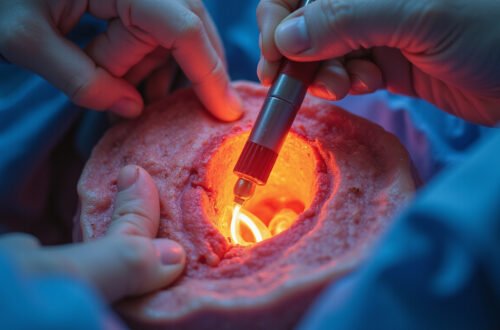If you or a loved one has been experiencing unexplained numbness, tingling, or muscle weakness, your healthcare provider may recommend a nerve conduction study to diagnose underlying nerve issues. This diagnostic test measures how well and how fast electrical signals travel through your nerves. Understanding what a nerve conduction study involves and its benefits can ease any apprehensions and help you prepare for the procedure.
In this article, we’ll explain what a nerve conduction study is, what to expect during the test, its benefits, and address some frequently asked questions to guide you through the process.
What Is a Nerve Conduction Study?
A nerve conduction study (NCS) is a non-invasive electrical test used to evaluate the function and health of your peripheral nerves. These are the nerves outside the brain and spinal cord responsible for transmitting signals that control sensation and muscle movement.
During an NCS, small electrodes are placed on your skin over nerves in areas such as your arms or legs. Mild electrical impulses are then sent through these electrodes to stimulate the nerve. The test measures the speed (conduction velocity) and strength of the electrical signals as they travel along the nerve.
The results help identify abnormalities such as nerve damage, compression, or disorders like carpal tunnel syndrome, peripheral neuropathy, or Guillain-Barré syndrome.
What to Expect During a Nerve Conduction Study
If you’ve never had a nerve conduction study before, you might feel anxious about the procedure. Here’s what typically happens:
-
Preparation
You won’t need much preparation for the test. It’s advisable to wear loose, comfortable clothing that allows easy access to the area being tested. Avoid applying lotions or oils on the skin before the test, as these can interfere with electrode placement. -
Electrode Placement
The technician or neurologist will place adhesive electrodes on your skin over the nerve and the area being measured. These electrodes detect the electrical signals and stimulate the nerve during the test. -
Stimulation and Measurement
You will feel a series of brief, mild electrical pulses—somewhat like a quick pinch or zap—on your skin. These impulses last only a fraction of a second and are generally tolerable. The test is painless but can cause slight discomfort. -
Duration
A typical nerve conduction study takes about 30 to 60 minutes, depending on the nerves tested and the complexity of your symptoms. -
After the Test
There is no downtime after the study. You can resume normal activities immediately.
Benefits of a Nerve Conduction Study
A nerve conduction study is invaluable for diagnosing and managing various nerve-related conditions. Here are key benefits:
- Accurate Diagnosis: NCS can pinpoint nerve damage location and severity, distinguishing between nerve and muscle problems.
- Early Detection: Identifying nerve issues early allows prompt treatment, which can prevent further damage.
- Guides Treatment Decisions: Test results help healthcare providers recommend the most appropriate therapies or interventions.
- Monitors Disease Progression: For chronic conditions, repeat studies assess whether a nerve disorder is improving, worsening, or stable.
- Non-Invasive and Safe: The procedure poses minimal risks and is widely considered safe, making it a reliable diagnostic tool.
Conditions Diagnosed by Nerve Conduction Studies
Nerve conduction studies are particularly useful for detecting a variety of neurological conditions including:
- Carpal Tunnel Syndrome: Compression of the median nerve at the wrist causing numbness and tingling.
- Peripheral Neuropathy: Damage to peripheral nerves often due to diabetes, infections, or toxins.
- Radiculopathy: Nerve root compression in the spine causing pain and weakness in the limbs.
- Guillain-Barré Syndrome: An autoimmune condition causing rapid-onset weakness.
- Chronic Inflammatory Demyelinating Polyneuropathy (CIDP): A disorder characterized by ongoing nerve inflammation.
How to Prepare for a Nerve Conduction Study
To ensure the best quality results from your nerve conduction study, consider these preparation tips:
- Avoid caffeine or smoking before your appointment as these can affect nerve responsiveness.
- Inform your doctor if you have a pacemaker or other implanted electronic device.
- Remove jewelry or metal objects before the test.
- Stay relaxed and communicate with the technician if you experience discomfort.
What Do the Results Mean?
Your nerve conduction study results include data about nerve conduction velocity and the amplitude of the electrical signals. Normal results indicate healthy nerve function. Slowed conduction velocities or decreased amplitudes suggest nerve damage or dysfunction.

Your neurologist or healthcare provider will interpret the findings in the context of your symptoms and medical history to confirm a diagnosis or recommend further testing.
Frequently Asked Questions About Nerve Conduction Study
Q1: Is a nerve conduction study painful?
A nerve conduction study generally causes only mild discomfort during electrical stimulation, similar to a quick pinch or zap. Most patients tolerate it well without significant pain.
Q2: How long does it take to get nerve conduction study results?
Results are usually available within a few days. Your healthcare provider will discuss the findings and their implications during a follow-up appointment.
Q3: Can a nerve conduction study detect early nerve damage?
Yes, nerve conduction studies can detect nerve damage before it becomes clinically obvious, enabling earlier diagnosis and treatment.
Expert Insight on Nerve Conduction Studies
According to the American Association of Neuromuscular & Electrodiagnostic Medicine, nerve conduction studies are considered essential in evaluating and diagnosing neuromuscular disorders. They are often combined with electromyography (EMG) for a comprehensive assessment (source).
Conclusion: Why You Should Consider a Nerve Conduction Study
If you’re experiencing unexplained numbness, weakness, or pain, a nerve conduction study offers a reliable, minimally invasive way to understand what’s going on inside your nervous system. Early diagnosis can prevent permanent nerve damage and significantly improve your quality of life.
Talk to your healthcare provider today about whether a nerve conduction study is right for you. By taking this step, you’re investing in better nerve health and unlocking a clearer path toward effective treatment and recovery. Don’t wait — get the answers you need to feel your best again!






